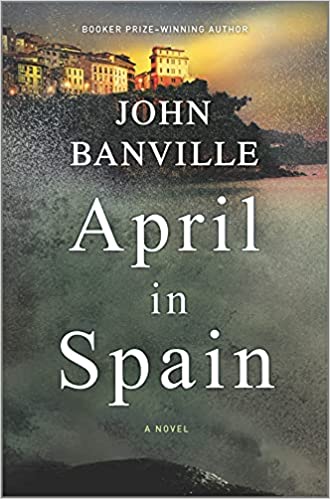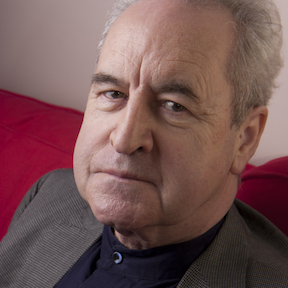Note: John Banville has been WINNER of The James Tait Black Memorial Prize, WINNER of The Booker Prize, WINNER of The Franz Kafka Prize, WINNER of The Austrian State Prize for European Literature, and WINNER of the Prince of Asturias Award for Literature.
“It was a mystery to him that not only had she married him, but had stuck with him, too, and showed no signs of letting go. Her steadfastness was the very thing that made him nervous, however, and sometimes, in the early morning especially, he would rear up in a panic to check that she was there beside him in bed, that she hadn’t given up on the whole project and slipped away in the night.”—Quirke, on his marriage.
 John Banville, writing here under his own name, has returned to writing mystery stories featuring the complex and often unlovable Dublin police pathologist, Quirke. All but one of Banville’s seven previous Quirke novels were written under the pen name of Benjamin Black, separating them from the bigger, more thematically thoughtful, and highly literary novels upon which he has built his reputation and won innumerable literary prizes, both in his native Ireland and on the world stage. Banville clearly enjoys the freedom of his mystery writing, however, and now uses his real name as author. Though these mysteries are “lighter” than his literary novels, he never sacrifices his sense of narrative direction, and he is careful to include well developed themes, taking the time to create many darkly ironic scenes and descriptions. While his numerous, often unusual, characters may sometimes stretch the limits of believability, he uses them to present plot elements which most other “literary” authors would be unable to include at all without being accused of “sensationalism.” In this novel especially, some characters have lived lives so filled with behavioral taboos that these behaviors have become a part of their “normal” lives. Other characters, including Quirke, have also spent their lives living on the edge, their lack of stability often related to a childhood spent in an orphanage, their coping strategies now found inside a bottle.
John Banville, writing here under his own name, has returned to writing mystery stories featuring the complex and often unlovable Dublin police pathologist, Quirke. All but one of Banville’s seven previous Quirke novels were written under the pen name of Benjamin Black, separating them from the bigger, more thematically thoughtful, and highly literary novels upon which he has built his reputation and won innumerable literary prizes, both in his native Ireland and on the world stage. Banville clearly enjoys the freedom of his mystery writing, however, and now uses his real name as author. Though these mysteries are “lighter” than his literary novels, he never sacrifices his sense of narrative direction, and he is careful to include well developed themes, taking the time to create many darkly ironic scenes and descriptions. While his numerous, often unusual, characters may sometimes stretch the limits of believability, he uses them to present plot elements which most other “literary” authors would be unable to include at all without being accused of “sensationalism.” In this novel especially, some characters have lived lives so filled with behavioral taboos that these behaviors have become a part of their “normal” lives. Other characters, including Quirke, have also spent their lives living on the edge, their lack of stability often related to a childhood spent in an orphanage, their coping strategies now found inside a bottle.
April in Spain opens in London, where Terry Tice, an Irishman who “liked killing people,” is now working for fusty Percy Antrobus – “heavy, pasty-faced, with a woman’s hips, and bruise-colored pouches under his eyes and a fat lower lip that sagged and turned a glistening shade of dark purple when he’d had a few.” Hired to kill Percy’s mother because she was threatening to cut Percy out of her will, Terry Tice shoots her “in broad daylight, grabbing her bag to make it look like garden snatch job done by some panicky kid,” and escapes, leaving no trail. The second setting is in Donostia, Spain, where Quirke and his wife Evelyn, a psychiatrist, are on holiday. An Austrian Jew, Evelyn has survived World War II, though many in her family did not. “In love” with Quirke, and he with her, though neither of them demonstrates it publicly, she always remains steadfast toward him, never losing her temper, no matter how outrageously he might act.
After he arrives in Spain, Quirke twice sees an Irish woman from a distance and believes he has seen her before, dismissing, temporarily, the idea that a physician friend of his daughter Phoebe in Dublin might actually be the person he has seen. The problem? His daughter’s friend, April Latimer, has disappeared and is believed dead. When Quirke cuts himself on an oyster shell and goes to the hospital in Donostia, however, he sees that same female doctor there, and he is now convinced she is April Latimer, his daughter’s friend, alive and practicing medicine in Donostia, Spain. Quirke calls Phoebe in Dublin, telling her that he believes that he has found her friend, and would like her to come to Spain to confirm his opinion. Wanting more information before she leaves for Spain, Phoebe naively, contacts April’s uncle, William Latimer, a highly placed, influential Dublin politician and meets with him to talk about April. William Latimer, however, is secretly fearful that Phoebe knows something of his political misdeeds and those of others close to him and that if those are revealed, they will ruin his career. It is in this section that the pathological horrors of the Latimer family relationships are revealed, suggesting some of the reasons that April might have disappeared to Spain, assumed a new name, and let people think she was dead.

Banville’s previous novel, SNOW, featured Det. St. John Strafford, who appears in April in Spain, too.
Worried about Phoebe’s meeting with Latimer, Quirke makes sure that she is accompanied by Officer Strafford from the Dublin Police as a safety measure when she leaves Ireland to join him in Spain. (Strafford is the main character of Snow, the 2020 mystery story published by John Banville last year.). Soon killer Terry Tice reappears in Spain, hired by “someone” in Dublin for a “foreign job.” Tice’s assignment is to assure that damaging revelations regarding William Latimer do not occur. Ultimately, with the participants in the three separate plot lines all coming together at the same time in Spain, the scene is set for a grand finale, and every member of each plot line plays a role in it. Banville does not disappoint in pulling off a memorable conclusion, though much of it follows a grand finale “pattern” of expectations for the reader, tying up loose ends quickly, and concluding the novel neatly. A dramatic surprise occurs which suggests that there may be future novels in the series.

Author John Banville
Throughout this review I have tried to avoid giving spoilers, as have other writers in their own reviews, but there is an “elephant in the room” in this novel. The Latimer family is a seriously disturbed family on many levels, guilty of crimes against each other that are rarely, if ever, featured in mainstream novels. While this is not the main story line, Banville uses this subplot to drive the action and raise questions about April’s disappearance throughout. The reasons for her disappearance become abundantly clear to the reader, but remain unnamed. Her additional actions as a young woman facing the devastating results of these family crimes against her raise yet another controversial topic. As a result, by the time Banville includes, in passing, references to priestly abuse of parishioners and children, and a scene of blatant substance abuse by one of the main characters here, those references have little, if any, shock value left. Banville writes a coherent, tense, and wide-ranging mystery, and he does it with drama and flair, with no subject considered off-limits, even if that subject remains forever unnamed.
Also by Banville: ANCIENT LIGHT, THE INFINITIES, THE SEA, THE UNTOUCHABLE, SHROUD
Mysteries by John Banville, written under the pen name of Benjamin Black: THE BLACK-EYED BLONDE, CHRISTINE FALLS, A DEATH IN SUMMER, THE SILVER SWAN, VENGEANCE
Photos. La Concha Bay in Donostia, Spain, is found on this site: https://www.pinterest.com
San Juan de Dios Hospital, where April worked and Quirke received treatment, is from https://clinicahospital.com
The portrait of author John Banville appears on https://literature.britishcouncil.org
The ponsol hat, which Evelyn purchased for Quirke, is found here: https://www.pinterest.es



